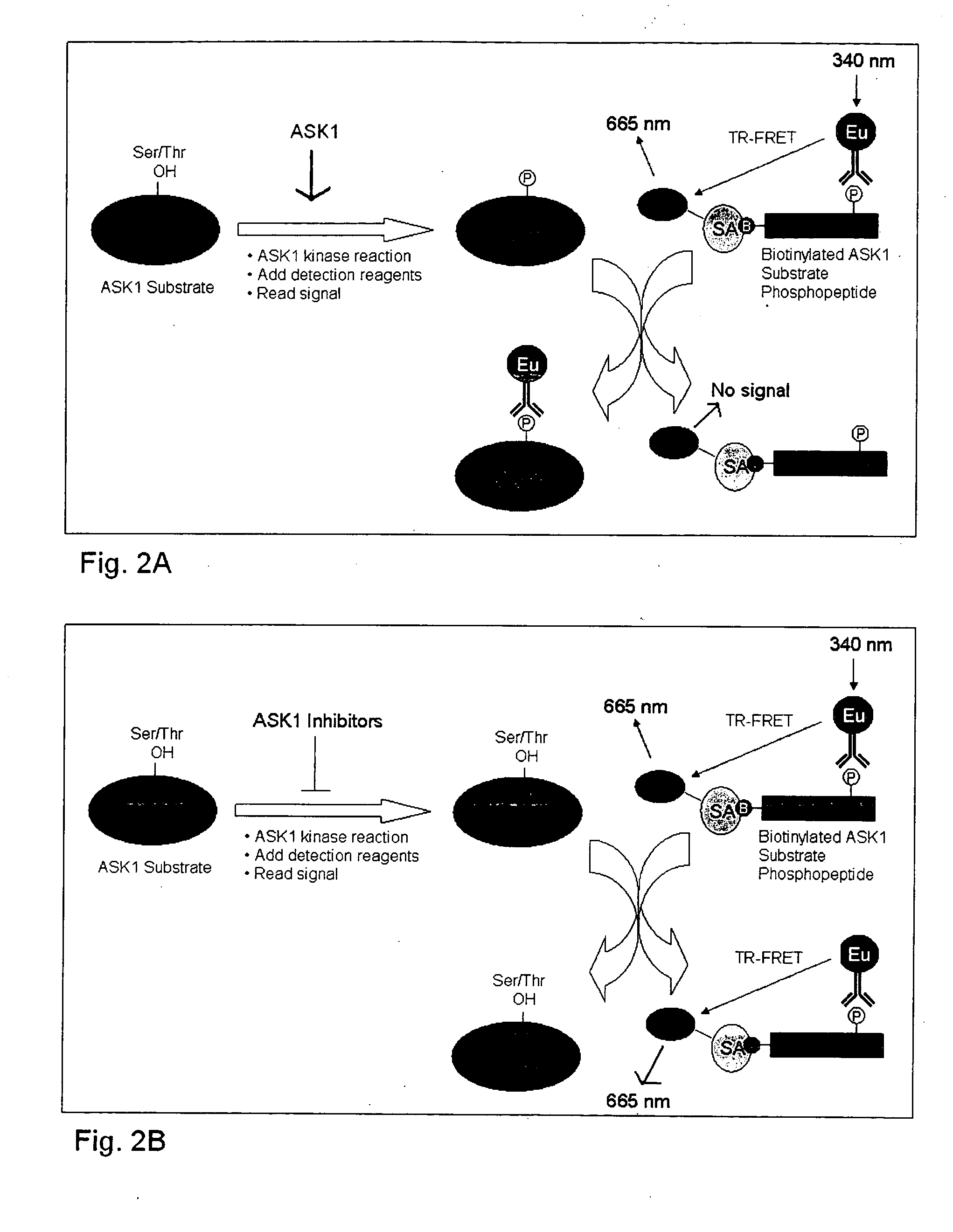Methods for identifying ASK1 inhibitors useful for preventing and/or treating cardiovascular diseases
a technology of ask1 and ask2, which is applied in the field of apoptosis signal-regulated kinase 1 and can solve problems such as challenging kinase targets, and achieve the effect of preventing and/or treating cardiovascular diseases
- Summary
- Abstract
- Description
- Claims
- Application Information
AI Technical Summary
Benefits of technology
Problems solved by technology
Method used
Image
Examples
example 1
[0048] This assay uses biotinylated full length physiologically relevant substrate proteins, such as MAP kinase kinases 3, 6, 4 and 7 (MKK3, MKK6, MKK4 and MKK7) or the generic ser / thr kinase substrate myelin basic protein (MBP). Recombinant ASK1 is used in a kinase reaction to phosphorylate the full length substrate protein. The proximity of the biotin tag and the phosphorylated ser / thr residue on the ASK1 substrate is visualized by bringing two fluorophores in close contact with each other, which allows fluorescence resonance energy transfer (FRET) to occur. One fluorophore (e.g. allophycocyanin) is attached to streptavidin, which binds to the biotin tag, and the other fluorophore (e.g Europium) is attached directly or indirectly to an antibody that recognizes the phosphorylated ser / thr residue. Only those ASK1 substrate molecules that have been phosphorylated will bring the two fluorophores in close enough contact to provide FRET, and thus the resulting assay is a very sensitive ...
example 2
[0050] Another format that is suitable for the screening of ASK1 catalytic activity inhibitors is to utilize a competitive assay format. In this assay format, a proximity dependent signal is pre-established on a biotinylated peptide containing a phosphorylated ser / thr residue at the site of ASK1 phosphorylation on the full length substrate. ASK1 is then utilized to phosphorylate an untagged full length substrate producing a phosphorylated full length substrate that competes for the phospho-specific detection reagent that is bound to the peptide. This ultimately leads to a decrease in the proximity dependent signal from the peptide (e.g. TR-FRET, SPA, AlphaScreen®). Consequently, inhibitors of ASK1 will reduce the competition by the full length substrate and result in an increase in the proximity dependent signal from the peptide. An illustration of a TR-FRET version of this assay is shown in FIGS. 2A and 2B, where the antibody that recognizes the phosphorylation is directly labeled ...
example 3
[0051] Another assay utilizes peptides derived from ASK1 substrates fused to a DVD docking domain. By providing the necessary docking site, these peptides would act as direct substrates for ASK1. Detection of the ASK1-dependent phosphorylation of these peptide substrates can be performed using proximity based methods (i.e. TR-FRET, AlphaScreen®, SPA) using biotinylated peptides or through the use of FP if the substrate peptide is fluorescently labeled. An illustration of a TR-FRET version of this assay is shown in FIGS. 3A and 3B, where the antibody that recognizes the phosphorylation is directly labeled with Europium. As with the assay described above in Example 1, ASK1 activity causes an increase in the assay readout, whereas inhibition of ASK1 activity is reflected in a loss of assay signal.
PUM
 Login to View More
Login to View More Abstract
Description
Claims
Application Information
 Login to View More
Login to View More - R&D
- Intellectual Property
- Life Sciences
- Materials
- Tech Scout
- Unparalleled Data Quality
- Higher Quality Content
- 60% Fewer Hallucinations
Browse by: Latest US Patents, China's latest patents, Technical Efficacy Thesaurus, Application Domain, Technology Topic, Popular Technical Reports.
© 2025 PatSnap. All rights reserved.Legal|Privacy policy|Modern Slavery Act Transparency Statement|Sitemap|About US| Contact US: help@patsnap.com



